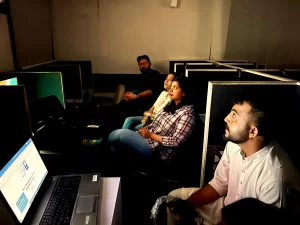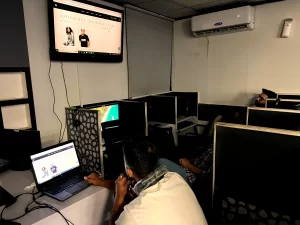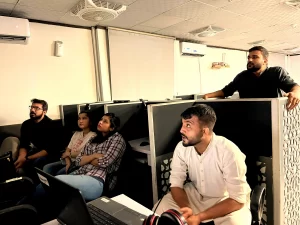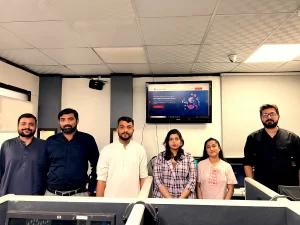In the fast-paced world of digital innovation, businesses are constantly seeking ways to enhance the user experience and stay ahead of the curve. One such innovation that has been making waves is the integration of voice recognition technology into content management systems (CMS).
To shed light on the transformative power of this technology, Binate Digital recently organized an insightful workshop for its employees. Mr. Sheeraz Khan, the Creative Production Head, led the workshop, with assistance from Mr. Bilal Hamza, the CMS Team Lead, as they delved into the intricacies of implementing voice recognition in CMS. In this article, we will take you through the journey of this enlightening session, highlighting how the trainers explained each step and emphasizing the potential it holds for businesses in the digital age.
On this Article
The Promise of Voice Recognition in CMS
As the workshop commenced, Mr. Sheeraz set the tone by underscoring the significance of voice recognition integration in CMS. He emphasized that this technology has the potential to revolutionize how users interact with websites. By allowing customers to engage with a website using their voice, businesses can offer a seamless and intuitive user experience. The trainers made it clear that achieving this functionality is well within reach, thanks to third-party assets and APIs.
Step 1: Choosing the Right Voice Recognition Service
Mr. Bilal Hamza took the stage to elucidate the first crucial step in implementing voice recognition in CMS: selecting the appropriate voice recognition service. He introduced the audience to renowned options such as Google Cloud Speech-to-Text, Amazon Transcribe, and Microsoft Azure Speech Service. Mr. Hamza emphasized the importance of signing up for an account with the chosen service and obtaining the requisite API keys or credentials. Through clear explanations and real-world examples, he ensured that the attendees grasped the significance of this initial decision.
Step 2: Installation and Configuration
With the foundation laid, the workshop transitioned to the practical aspect of integration. The trainers introduced the audience to assets like “Voice Search” and “Voice Search & Voice Typing for CMS,” which simplify the installation and configuration process. They highlighted that these assets serve as invaluable tools, streamlining the technical complexities of integration. Attendees were encouraged to follow along, fostering a hands-on learning experience.
Step 3: Setting Up API Integration
Mr. Bilal Hamza then guided the participants through the intricate process of setting up API integration. He explained how this step acts as the bridge between the CMS website and the chosen voice recognition service. Attendees learned the importance of entering API keys or credentials into the website’s dashboard asset settings. Mr. Hamza’s expertise and patience ensured that even those new to the concept of API integration could follow along effectively.
Step 4: Adding Voice Search Functionality
As the workshop progressed, Mr. Sheeraz took the reins to discuss the pivotal step of adding voice search functionality to a website. He outlined the various ways this could be accomplished, often involving the integration of a voice search button or widget into the site’s search bar or other relevant areas. The trainers encouraged participants to explore different methods, fostering a creative and interactive learning environment.
Step 5: Customizing the User Interface
In the world of web design, aesthetics play a crucial role. Mr. Sheeraz elaborated on the importance of customization, particularly when it comes to the user interface. Depending on the asset chosen, attendees were shown how they could tailor the appearance and behavior of the voice search feature to align with their website’s design and user experience. The trainers demonstrated that a well-designed interface not only enhances functionality but also creates a cohesive user journey.
Step 6: Testing and Optimization
No implementation is complete without rigorous testing. The workshop attendees were encouraged to delve into this critical phase, where they would ensure that the voice recognition feature operated as expected. Mr. Bilal Hamza stressed the need for meticulous attention to detail, particularly regarding the accuracy of speech-to-text conversion. Attendees were shown how to make adjustments as necessary, reinforcing the importance of iteration in web development.
Step 7: Accessibility Considerations
Web accessibility is a non-negotiable aspect of modern web design. Mr. Sheeraz and Mr. Bilal Hamza brought attention to the ethical obligation of ensuring that voice recognition implementations comply with accessibility standards. They emphasized the need to provide alternative text-based search options for users with disabilities or those who prefer traditional input methods. In doing so, they conveyed a commitment to inclusivity and equal access to information.
Step 8: Promoting Voice Search
Once the technical aspects were covered, the trainers shifted their focus to user adoption. Mr. Sheeraz emphasized the importance of informing users about the availability of voice search on a website. He encouraged his listeners to consider creating user guides or tutorials to help users understand how to use the feature effectively. This step underlined the trainers’ holistic approach to implementation, which extends beyond the technical realm into user education and engagement.
Step 9: Monitoring and Continuous Improvement
The workshop culminated with a forward-looking perspective on implementation. Mr. Bilal Hamza urged participants to view voice recognition integration as an ongoing process. He stressed the importance of continuously monitoring user feedback and analytics to identify areas for improvement. Attendees were reminded that user suggestions and data should drive the refinement of the voice recognition feature. This concluding message reinforced the workshop’s commitment to excellence and staying at the forefront of user experience.
In A Nutshell
In closing, the workshop on voice recognition in CMS, led by Mr. Sheeraz and assisted by Mr. Bilal Hamza, illuminated the path to a more engaging and efficient user experience. The trainers expertly guided attendees through each step of implementation, emphasizing not only the technical aspects but also the ethical and user-centric considerations. As businesses continue to vie for user attention in the digital realm, embracing voice recognition technology may well be the key to unlocking a brighter future for web interaction.












